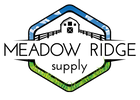Horse fences can be one of the most attractive and valuable additions to any farm. But if you’ve considered adding a fence to your property, you’re probably well aware of the many obstacles that can turn a seemingly simple project into a complicated undertaking. Before you place your order, here are five things you should keep in mind to get the most out of your investment.
-
UNDERSTAND YOUR OPTIONS
Have you ever wondered why a ranch fence can stand for 25 years but your deck begins to rot in as few as eight years? It’s because the wood products sold in retail stores are treated for human contact and are not designed to withstand great force, extreme weather, fungus, and other elements. All Meadow Ridge Supply products are designed for agricultural use, are long lasting, and cannot be used for anything other than ground contact fencing.
As you’re determining spacing, you may find that your posts are not set perfectly at eight feet. In order to simplify the installation process, Meadow Ridge Supply’s boards are not cut using precise measurements. This allows for trimming and helps guarantee the materials you order will meet your needs.
It’s also important to keep wood protection in mind when building a fence. Our boards are all ruff sawn without any smoothing or sanding. This is important because it will allow paint to stick to the surface and help to maintain your fence’s structural integrity.
-
CONSIDER COST AND MAINTENANCE
You may be tempted by the convenience of your local lumber yard or home improvement store when it comes to buying boards and posts for your new fence. But if you choose this option, you will soon find that this is a very expensive decision. Not only are these options more costly than Meadow Ridge Supply, but customers find that the materials are inferior, experience difficulty getting paint to adhere to the surface, and even pay more for shipping to their location. Over time these materials will also need to be replaced or repaired, leaving some boards looking newer than others and patched.
-
WHAT NEEDS TO BE DONE BEFORE INSTALLATION (SURVEY YOUR YARD AND LOCATE UTILITIES, TREE ROOTS, ROCKY SOIL, UNEVEN LAND, AND OTHER EXISTING STRUCTURES)
Although you may have the location of your fence planned, there are a few things to consider before you begin installation. Survey your land for any trees, roots, rocky soil, uneven land, or any other existing structures that are in your path. It is important to make sure these potential impediments are taken care of before you begin your project. You will also want to locate all utilities in the general vicinity where you will be digging. Whether you’re hiring a professional or doing the work yourself, call 811 at least a few days before you start to identify underground utilities. Digging without knowing the approximate location can lead to service disruptions, serious injury, and costly repairs.
In order to ensure your fencing is straight, mark the location and pull a draw line to determine the exact placement. From here, you will want to set corner posts and use a line at the top to guide your fencing runs. You will need to determine the depth of your post placement before installation. In the north, for instance, your frost level will need to be determined to avoid your posts being lifted from the ground by the force of frost. Gate locations and sizes should also be noted in advance to prevent any issues with the installation process.
-
THINK ABOUT YOUR NEIGHBORS
Fence etiquette is important to keep in mind before you install your fence. Although it isn’t a requirement, a friendly conversation with your neighbor can go a long way in preventing any misunderstandings or confusion before you install a costly investment. After all, your fence may border their property and affect their yards, too. Refer to your property’s boundary lines to make sure you’re within your perimeter. If you don’t have this information, you may need to hire a professional land surveyor to physically mark your boundary lines. Keep in mind, it is against the law to install a fence over your property line. Doing so could result in having to tear down your fence.
-
FACTOR IN HOME VALUE
In addition to keeping your horses safe and showcasing your estate, quality Michigan pine board fencing enhances property values for you and your neighbors. A beautiful fence frames your property and is a can be a form of creative expression. You may consider cutting costs by only using posts and wire fencing; however, when you look at the price and impact of boards over metal wire, the difference is minimal. A long-lasting Three-board or four-board wood fence will age better than wire, require infrequent repairs or replacement, and have a profound impact on the value of your real estate.
